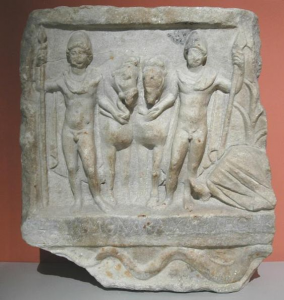SUNDAY, JUNE 9, 2019 · 2 MINUTES READ
By Konstantinos Kottis  A basic interpretative proposition of the excavation team on Kastas hill near Amphipolis is that the monument was one of Hephaestion Heroons. However, we have no source indicating or other evidences that Hephaestion receive heroic or divine honours in the region of Amphipolis, a great city that controlled until 316 BC by the mother of the Great Alexander queen Olympias, through her partner and governor of the city Aristonus. We know that this city have offered divine honours to Philip II (359-336). The same city has got monuments for the two of its founders, the homeric’s first founder Rhesus and the 2nd founder, the Spartan general Brassidas. Finally, we know that the Amphipolis region has got two famous tumuli, the great tumulus of Phyllis and the Biton’s Heroon.
A basic interpretative proposition of the excavation team on Kastas hill near Amphipolis is that the monument was one of Hephaestion Heroons. However, we have no source indicating or other evidences that Hephaestion receive heroic or divine honours in the region of Amphipolis, a great city that controlled until 316 BC by the mother of the Great Alexander queen Olympias, through her partner and governor of the city Aristonus. We know that this city have offered divine honours to Philip II (359-336). The same city has got monuments for the two of its founders, the homeric’s first founder Rhesus and the 2nd founder, the Spartan general Brassidas. Finally, we know that the Amphipolis region has got two famous tumuli, the great tumulus of Phyllis and the Biton’s Heroon.
About Biton’s Heroon, Nicaenetus refers in a tomb epigram:
Ἠρίον εἰμί Βίτωνος, ὁδοιπόρε· εἰ δέ Τορώνην λείπων εἰς αὐτήν ἔρχεται Ἀμφίπολιν, εἰπεῖν Νικαγόρᾳ, παίδων ὅτι τόν μόνον αὐτῷ Στρυμονίης Ἐρίφων ὤλεσε πανδυσίῃ
(Epigram of Nicaenetus, Παλατινή Ἀνθολογία, VIΙ, «Ἐπιτύμβια», 502, in Anthologia graeca ad palatini codicis fidem edita, I (Lipsiae: C. Tauchnit, 1819), 338.Translation: “Oh Traveler! I am the Heroon who they dedicated to Biton. If you leaving from Torone of Chalkidiki to comest to Amphipolis, tell to Nicagoras that the Strymonian wind at the star setting of the Eriphi’ (at the middle of September) was the sunset (death) of his only son.”
Nicaenetos who wrote this epigram lived in the 3rd century BC at the island of Samos but originated from the Abdera of Thrace. He therefore refers to a Heroon dating since 3rd century BC and earlier ( ; ), at a time when the holy monument of Kastas΄Hill and tomb near of Amphipolis still works and has not been seized by the Romans.

Hellenic Art of Roman period, Archaeological Museum of Amphipolis


